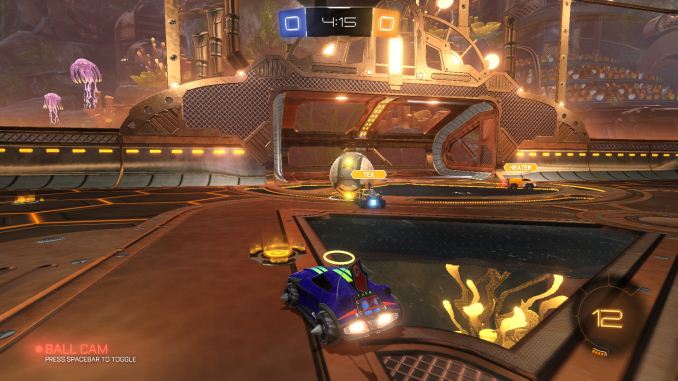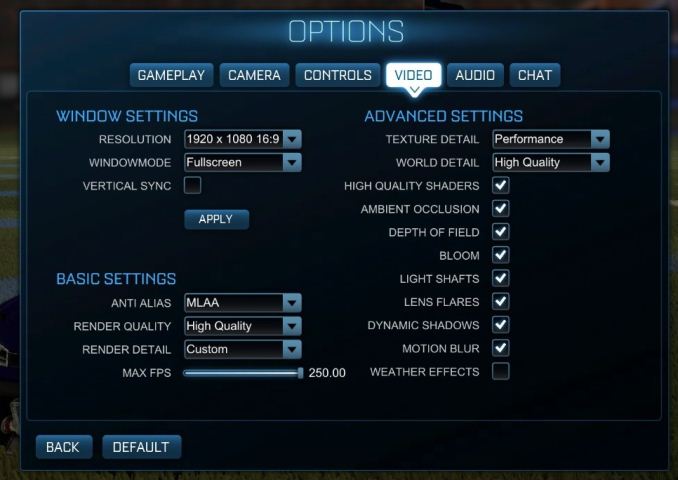Retesting AMD Ryzen Threadripper’s Game Mode: Halving Cores for More Performance
by Ian Cutress on August 17, 2017 12:01 PM ESTRocket League
Hilariously simple pick-up-and-play games are great fun. I'm a massive fan of the Katamari franchise for that reason — passing start on a controller and rolling around, picking up things to get bigger, is extremely simple. Until we get a PC version of Katamari that I can benchmark, we'll focus on Rocket League.
Rocket League combines the elements of pick-up-and-play, allowing users to jump into a game with other people (or bots) to play football with cars with zero rules. The title is built on Unreal Engine 3, which is somewhat old at this point, but it allows users to run the game on super-low-end systems while still taxing the big ones. Since the release in 2015, it has sold over 5 million copies and seems to be a fixture at LANs and game shows. Users who train get very serious, playing in teams and leagues with very few settings to configure, and everyone is on the same level. Rocket League is quickly becoming one of the favored titles for e-sports tournaments, especially when e-sports contests can be viewed directly from the game interface.
Based on these factors, plus the fact that it is an extremely fun title to load and play, we set out to find the best way to benchmark it. Unfortunately for the most part automatic benchmark modes for games are few and far between. Partly because of this, but also on the basis that it is built on the Unreal 3 engine, Rocket League does not have a benchmark mode. In this case, we have to develop a consistent run and record the frame rate.
Read our initial analysis on our Rocket League benchmark on low-end graphics here.
With Rocket League, there is no benchmark mode, so we have to perform a series of automated actions, similar to a racing game having a fixed number of laps. We take the following approach: Using Fraps to record the time taken to show each frame (and the overall frame rates), we use an automation tool to set up a consistent 4v4 bot match on easy, with the system applying a series of inputs throughout the run, such as switching camera angles and driving around.
It turns out that this method is nicely indicative of a real bot match, driving up walls, boosting and even putting in the odd assist, save and/or goal, as weird as that sounds for an automated set of commands. To maintain consistency, the commands we apply are not random but time-fixed, and we also keep the map the same (Aquadome, known to be a tough map for GPUs due to water/transparency) and the car customization constant. We start recording just after a match starts, and record for 4 minutes of game time (think 5 laps of a DIRT: Rally benchmark), with average frame rates, 99th percentile and frame times all provided.
The graphics settings for Rocket League come in four broad, generic settings: Low, Medium, High and High FXAA. There are advanced settings in place for shadows and details; however, for these tests, we keep to the generic settings. For both 1920x1080 and 4K resolutions, we test at the High preset with an unlimited frame cap.
All of our benchmark results can also be found in our benchmark engine, Bench.
MSI GTX 1080 Gaming 8G Performance

1080p



4K



Sapphire Nitro R9 Fury 4G Performance

1080p



4K



Sapphire Nitro RX 480 8G Performance

1080p



4K



With Ryzen, we encounted some odd performance issues when using NVIDIA-based video cards that caused those cards to significantly underperform. However equally strangely, the issues we have with Ryzen on Rocket League with NVIDIA GPUs seem to almost vanish when using Threadripper. Again, still no easy wins here as Intel seems to take Rocket League in its stride, but Game mode still helps the 1950X. The Time Under graphs give some cause for concern, with the 1950X consistently being at the bottom of that graph.












104 Comments
View All Comments
WoWFishmonger - Thursday, August 17, 2017 - link
I thought it was "The proof is in the PUDDING"All this time I've been eating pudding, looking for proof..... explains why I haven't found any yet. :|
Nice write up, its good to see that even if people won't use this new mode, they do have the choice to enable it.
Nothing wrong with choice IMO.
Ian Cutress - Thursday, August 17, 2017 - link
Heh, wow. That's a bad typo. Fixed, thanks :)edzieba - Thursday, August 17, 2017 - link
"I thought it was "The proof is in the PUDDING""The phrase is: "the proof of the pudding is in the eating".
boozed - Thursday, August 17, 2017 - link
ThisAlexvrb - Saturday, August 19, 2017 - link
I've always heard "the proof is in the pudding". The shorter version's meaning is still pretty apparent. Plus it rolls off the tongue better, so to speak. Mmmm..... pudding.sprockincat - Thursday, August 17, 2017 - link
While we're on the topic, I think it's "Game Mode as originally envisioned by AMD."NikosD - Thursday, August 17, 2017 - link
So, you read my comment regarding your mistake at the first TR review of assuming a 16C/16T CPU after enabling Game Mode instead of a 8C/16T and you corrected that in your new review.Now, you only have to repeat your tests with DDR4-3200 and select a different, more "workstation" kind of benchmarks in order to test monsters of 32 threads and not PDF opening of course !
Mercy !
Aisalem - Thursday, August 17, 2017 - link
For the average person reading most of tech sites the more workstation benchmarks doesn't really makes sense.What I would like to see if you can enable game mode and disable SMT. That will leave 1950X with 8 cores available to the system which still should be enough for gaming but might present even better results.
Zstream - Thursday, August 17, 2017 - link
For the love of all things... no one buys TR to just play games, or open .PDF's.Gothmoth - Thursday, August 17, 2017 - link
well noobs do.but i think websites like anandtech should know better.. but well anand is gone and.
the new generation is obviously no adequat replacement.